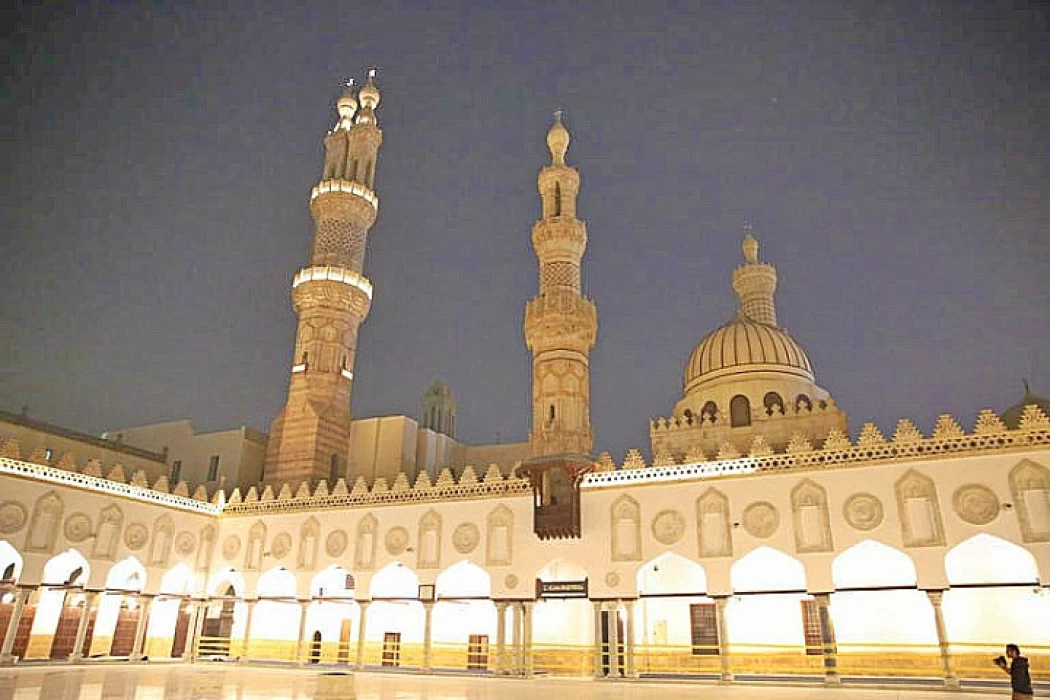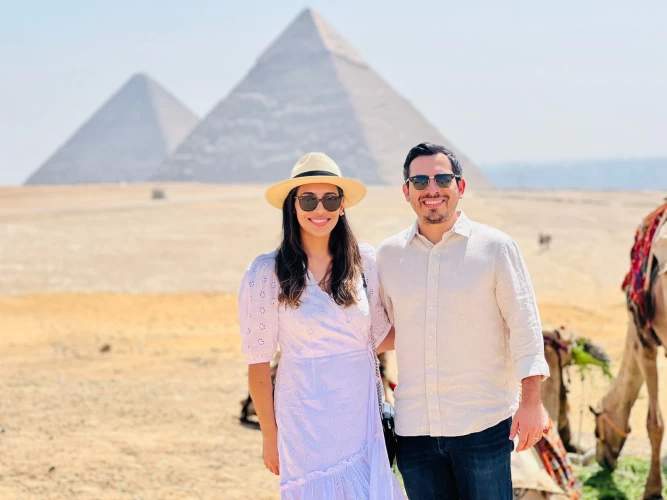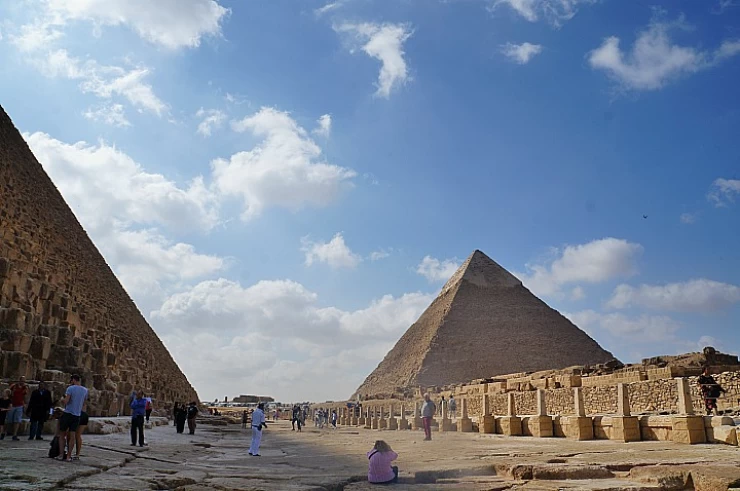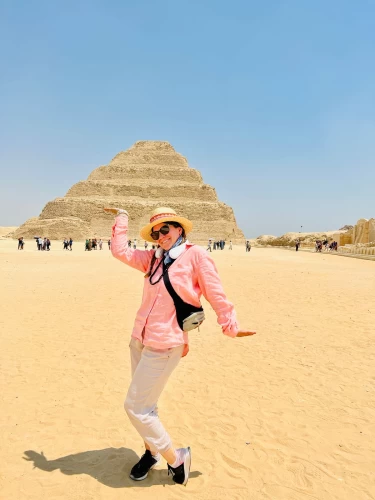
Mesquita de Al Azhar
Mesquita Al-Azhar
A Mesquita Al Azhar é uma das incríveis mesquitas e coisas a fazer no Cairo, considerada a primeira Universidade da história construída há mais de mil anos no Cairo, as pessoas que visitam Khan El Khalili podem ver a mesquita durante as suas Excursões do Dia do Cairo.
Foi no final do século X ser a mesquita oficial para as orações congregacionais realizadas todas as sextas-feiras e é conhecida em A rabic como Jummah.
Cairo islâmico
O construtor da fascinante mesquita de Al Azhar, tão antiga como a própria cidade do Cairo, é também o grande líder do exército de Fatimid e o construtor do Cairo, Gawhar El Seqelly, com as ordens do califa de Fatimid, Al Mui'z le Din Allah. A construção de Al Azhar, que tem de ser vista durante os Pacotes de Viagens regulares do Egipto ou excursões diárias do Cairo a partir do Aeroporto, começou em 970 d.C. e demorou cerca de três anos a ser concluída.
Desenho arquitectónico da Mesquita de Al Azhar:
Inicialmente, Al Azhar foi construída em metade da área que ocupa actualmente. Ampliações, novos edifícios e restauros foram realizados por vários califas, reis, sultões e presidentes do Egipto durante as várias épocas até a mesquita atingir o tamanho e a forma que tem hoje. A primitiva mesquita de Al Azhar consistia em três Iwans ou salões de oração, e no centro, há um campo aberto chamado Sahn. A entrada para a mesquita estava localizada na direcção do Ocidente e esta secção continha uma torre simples ou como é chamada na arquitectura islâmica Minaret concebida ao estilo Fatimid. Esta secção foi decorada com inscrições islâmicas Kofi e motivos florais, que são a única característica remanescente da antiga mesquita que ainda se encontra disponível agora.
No entanto, a maior arquitectura da Mesquita Al-Azhar foi executada por "Abd al-Rahman bin Katkhuda" no ano (1167 AH = 1753 AD) e ele gostava de construir e de construir. Depois acrescentou ao corredor do qiblah um novo compartimento de oração separado do compartimento original por pilares de pedra, e três degraus erguem-se a partir dele, E tem três mihrabs, e estabeleceu uma grande porta do lado noroeste que actualmente domina a Praça Al-Azhar, constituída por duas portas adjacentes, conhecida como a Porta de Muzain, e também introduziu uma nova porta chamada Porta de Al-Sa'idah e criou um minarete ao seu lado que ainda existe até agora, e esta porta leva aos meses de Al-Sa'idah. Os corredores de Al-Azhar.
A Mesquita de Al Azhar no Período Fatimid
Talvez a primeira arquitectura introduzida a Al-Azhar tenha sido realizada pelo califa fatimida, que preservou a religião de Deus, no Cairo islâmico, onde aumentou a área dos pórticos; na era Mamluk, os sultões cuidaram de Al-Azhar depois da negligência que sofreu na era Ayyubid, e o príncipe "Izz al-Din Aydar foi o primeiro a preocupar-se com Al-Azhar, pelo que renovou as partes que lhe foram rachadas. E no seu esplendor, a vida chegou ao fim após uma pausa, e o povo celebrou as orações de sexta-feira no seu dia (18 Rabi` al-Awwwal ano 665 AH = 19 de Novembro 1266AD). que podem ser vistas hoje no museu de Artes Islâmicas durante as excursões do dia do Egipto no Cairo. Em 1125 A.D., o governante Fatimid Al Amer be'ahkam Allah estabeleceu um Mihrab para a mesquita (um nicho que indica o caminho a seguir para rezar para Ka'aba) feito de madeira turca Aro que foi decorada com muitas formas florais e geométricas.
Al Azhar No Período Mamluk:
A arquitectura da Mesquita de Al-Azhar não parou durante o reinado dos Mamelucos Circassianos, onde o Sultão Qaitbay Al-Mahmoudi (873 AH = 1468 CE) demoliu a porta do lado noroeste da mesquita, construiu-a novamente tal como está agora, e construiu à sua direita um gracioso minarete dos mais belos minaretes do Cairo, depois o Sultão Qansuh al-Ghuri construiu o minarete de duas cabeças, o mais alto dos minaretes de Al-Azhar, um estilo único do minarete que é raro no mundo islâmico.
Uma nova madrasa (escola religiosa), a instituição de ensino islâmico Tabrisy Madrasa, foi construída por Baybars Khazendar, o comandante do exército no reinado de Al Nasser Mohamed Ibn Qalaun. Encontra-se à direita quando se entra na mesquita de Al Azhar. Isto acrescentou um espaço maior à mesquita que albergava aulas de ensinamentos islâmicos e também tinha uma grande biblioteca islâmica.
A Afghaweya Madrasa foi construída em 1340 d.C. e está situada no lado esquerdo da entrada. Contém a biblioteca de Al Azhar na época actual.
Al Azhar Na Era do Otomano:
Al Azhar sofreu uma grande expansão na era do otomano. O maior e mais importante trabalho de construção foi feito pelo Amir Abdel Rahman Katkhuda em 1753 d.C., ao expandir a área da mesquita, acrescentando um riwaq (pórtico) atrás do mihrab que foi construído a um nível superior ao de toda a mesquita. Acrescentou também um novo minbar e um mihrab. Katkhuda adicionou também dois grandes portões: o primeiro na parede sul chamado portão Sa'ayda e o portão Shroba na secção leste da mesquita com um minarete adicionado ao lado. Katkhuda foi também responsável pela construção do belo portão ocidental com as suas incríveis decorações islâmicas e que é agora a entrada principal da mesquita.
Al Azhar foi também restaurado pelo conselho supremo das antiguidades para finalmente ter este aspecto nos tempos modernos durante as suas visitas à mesquita através dos vários passeios nocturnos do Cairo. Al Azhar como mesquita e como instituição educacional tem desempenhado um papel importante em tantos séculos de história egípcia, especialmente na luta contra a ocupação francesa e britânica.
Universidade de Al Azhar :
A Universidade Al Azhar é a maior e mais importante instituição de ensino islâmico em todo o mundo e é a segunda universidade islâmica moderna a ser construída. O ensino islâmico na Universidade de Al Azhar foi transformado do ensino xiita para o ensino sunita a partir da era Fatimid e continua a ser uma das mais importantes e prestigiadas instituições de ensino no Egipto e em todo o mundo.
Ver Al Azhar e muitas outras mesquitas, igrejas e sinagogas durante os nossos Pacotes de Viagem ao Egipto, como por exemplo:
No Egito, há um lugar especial chamado Turismo de Assuã. É um lugar onde você pode aprender sobre a cultura e a história do Cairo islâmico.
Al Azhar Mosque |
Al Azhar house of prayer is one of the wonderful mosques and things to do in Cairo, it considered is the primary University in history engineered over one thousand years past in Cairo, folks visiting Khan El Khalili can see the house of prayer throughout their Cairo Day Tours. it had been towards the tip of the tenth century to be the official house of prayer for the congregational prayers control each Friday and is thought in a very rabic as Jummah.
The developer of the fascinating house of prayer of Al Azhar is as previous because the town of Cairo itself is additionally the good Fatimid army leader and also the builder of Cairo, Gawhar El Seqelly, with the orders of the Fatimid caliph, Al Mui'z le Din Allah. The building of Al Azhar that needs to be seen throughout the regular Egypt Travel Packages or Cairo day tours from the Airport began in 970 A.D. and it took around 3 years to be accomplished.
Architectural style Of Al Azhar Mosque: Initially, Al Azhar has engineered on 1/2 of the realm it occupies presently. Enlargements, new buildings, and restorations are meted out by many Caliphs, kings, sultans, and presidents of Egypt throughout the varied eras till the house of prayer reached the dimensions and the form it's nowadays. the first house of prayer of Al Azhar consisted of 3 Iwans or prayer halls, and within the center, there's an associate degree open court known as Sahn. the doorway to the house of prayer was set in toward the West and this section contained a straightforward tower or as known as in Muslim design tower designed within the Fatimid style. This section was adorned with Kofi Muslim inscriptions and floral motives, which are the sole remaining feature of the traditional house of prayer that's still obtainable currently.
However, the biggest design of the Al-Azhar house of prayer was performed by “Abd al-Rahman bin Katkhuda” within the year (1167 AH = 1753 AD) and he was keen on building and construction.
Then he else to the corridor of the qiblah a brand new prayer compartment separated from the initial compartment by stone pillars, and 3 steps rise from it, And it's 3 mihrabs, and established an oversized door from the northwestern aspect that presently overlooks Al-Azhar sq., consisting of 2 adjacent doors, referred to as the Gate of Muzain, and conjointly introduced a brand new door known as the Gate of Al-Sa'idah and created a tower beside it that also exists so far, and this door results in the Al-Sa’idah months. The corridors of Al-Azhar.
Al Azhar house of prayer within the Fatimid amount
Perhaps the primary design introduced to Al-Azhar was meted out by the Fatimid caliph, to preserve the faith of God, in Islamic Cairo, wherever he enhanced the realm porticos; within the Mamluk era, the sultans took care of Al-Azhar once the neglect it suffered within the Ayyubid era, and patrician “Izz al-Din Aydar was the primary to worry concerning Al-Azhar, thus he revived the elements that were cracked from him. And in its splendor, life came to an associate degree finish once a chance, and also the folks celebrated the Friday prayers in it on the day (18 Rabi` al-Awwal year 665 AH = nineteen Gregorian calendar month 1266AD). which will be seen nowadays within the depository of Muslim Arts throughout Egypt day tours in Cairo. In 1125 A.D., the Fatimid ruler Al Amer Be'ahkam Supreme Being established a Mihrab for the house of prayer (a niche that indicates that thanks to praying towards Ka'aba) created out of Aro Turkish wood that was adorned with loads of floral and geometric shapes.
Al Azhar within the Mamluk Period:

The design of the Al-Azhar house of prayer failed to stop throughout the reign of the Circassian Mamluks, wherever grand Turk Qaitbay Al-Mahmoudi (873 AH = 1468 CE) razed the door on the northwestern aspect of the house of prayer, engineered it once more because it is currently, and engineered on its right a sleek tower of the foremost lovely minarets of Cairo, Then grand Turk Qansuh al-Ghuri engineered the two-headed tower, the very best of the minarets of Al-Azhar, a novel variety of the tower that's rare within the Muslim world.
A new madrasa (religious school), the Tabrisy religious school Muslim teaching establishment, was engineered by Baybars Khazendar, the military commander during the reign of Al Nasser Mohamed Ibn Qalaun. it's set to the proper hand after you enter the Al Azhar house of prayer. This else a much bigger house than the house of prayer that hosted Muslim teachings categories and conjointly had an oversized Muslim library.
The Afghaweya religious school was inbuilt in 1340 A.D. and it's set on the left-hand aspect of the doorway. It contains the library of Al Azhar nowadays.
Al Azhar underwent plenty of growth within the Ottoman era. the {most important|the largest} and most important building work was done by the ruler Abdel Rahman Katkhuda in 1753 A.D. as he expanded the world of the house of prayer by adding a Riwaq (portico) behind the mihrab that was engineered on the next level than the full house of prayer. He additionally added a new minbar and mihrab. Katkhuda additional 2 nice gates as well: the primary within the southern wall referred to as the Sa'ayda gate and therefore the Shroba gate within the section of the house of prayer with an added minaret beside it. Katkhuda was additionally liable for building the attractive western gate with its superb Muslim decorations and that is currently the entrance of the house of prayer.
Al Azhar has been additionally renovated by the supreme council of antiquities to finally appear as if this within the trendy time throughout your visits to the house of prayer through the assorted Cairo overnight tours. Al Azhar as a house of prayer and as an academic establishment has to compete for a significant role in numerous centuries of Egyptian history, particularly in fighting the French and British occupation.


















